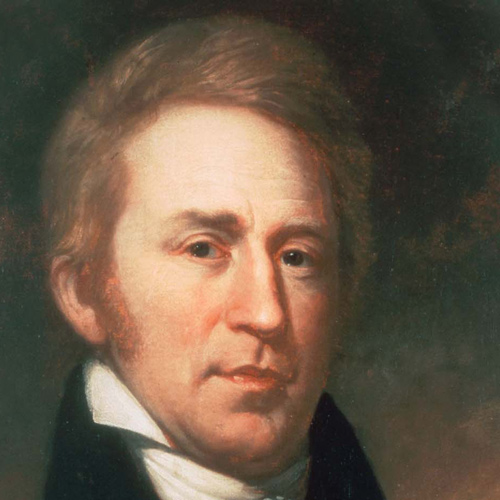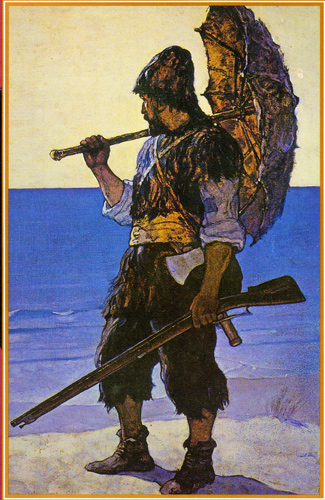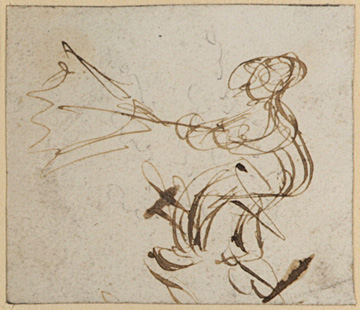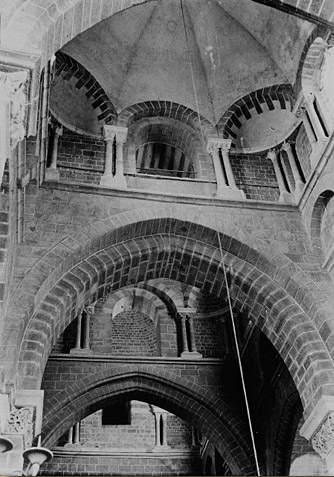There may have been one good personal reason for Clark’s umbrella. At the epidermal level, he likely had more melanin. And there is more to the story of his umbrella.
Clark family lore maintains that red hair was introduced into the Clark blood line by the red-headed Scottish wife of the John Clark who emigrated to Virginia in the late seventeenth century. Charles Willson Peale‘s reputation as a portraitist was built on the lifelike qualities of his paintings, and his portrait of William Clark, painted in 1807, clearly portrays him as a redhead. Although Peale apparently did not show any freckles on Clark’s face, he certainly gave him a different complexion than he saw in Lewis’s visage.
A Matter of Melanins?
During the Napoleonic wars some British officers carried umbrellas into battle, but the practice was unauthorized, and it reaped ridicule from French critics. The instrument might have been a standard part of every officer’s kit in the U.S. Army in 1804,[1]William E. Foley, Wilderness Journey: The Life of William Clark (Columbia: University of Missouri Press, 2004), 2.. Robert J. Moore, Jr., and Michael Haynes, Tailor Made, Trail Worn: Army Life, … Continue reading but there is no evidence whatsoever that Lewis took one on the expedition. In any case, there may have been one good personal reason why Clark carried his.
Beneath our skins we’re all supposed to be pretty much alike, but at the epidermal level there are some conspicuous differences that we owe to melanin (MEL-a-nin; from the Greek word melan, meaning black). Melanin is a natural pigment (from Latin, pigmentum, from pignare, to paint) that gives color to our skin, hair, and the irises of our eyes. It protects the dermis-the layer containing nerve endings, sweat and oil glands, and blood and lymph vessels—from being damaged by ultraviolet solar radiation. There are two types, eumelanin (from Greek eu-, dark), which produces dark skin, dark eyes, and black or brunette hair, and the lighter phaeomelanin (pheo-, from Greek phaios, dusky), which is responsible for fair-skinned, blue-eyed, blond and red haired individuals. During the evolution of human biology, people native to equatorial climates developed comparatively high concentrations of eumelanin, while those native to more temperate zones, such as the continent of Europe, had more phaeomelanin than eumelanin.[2]Medline Plus, http://www.nlm.nih.gov/medlineplus/ency/article/002256.htm; PubMed, National Library of Medicine, http://www.ncbi.nlm.nih.gov/ (accessed 1/04)
Red hair is rare in the tropical latitudes where eumelanin is highly concentrated in native peoples, and is similarly uncommon in Asia. The population of Scotland is said to contain the highest proportion of redheads—13%, or about four times as many as in the United States. Red-haired persons, whose systems are deficient in eumelanins, often have rather pale skin that inclines more toward sunburn than suntan, and often develops freckles.
Clark’s Umbrella
Robinson Crusoe
by N. C. Wyeth (1882–1945)
This early illustration from 1920 is in the Public Domain.
One of the most famous umbrellas in literature is the one made by Robinson Crusoe, the fictional castaway invented by Daniel Defoe. Crusoe described the making of it:
I spent a great deal of time and pains to make an umbrella. I was indeed in great want of one, and had a great mind to make one. I had seen them made in the Brazils, where they are very useful in the great heats which are there, and I felt the heats every jot as great here, and greater too, being nearer the equinox; besides, as I was obliged to be much abroad, it was a most useful thing to me, as well for the rains as for the heats. I took a world of pains at it, and it was a great while before I could make anything likely to hold; nay, after I thought I had hit the way, I spoiled two or three before I made one to my mind. But at last I made one that answered indifferently well; the main difficulty I found was to make it to let down. I could make it spread, but if it did not let down too, and draw in, it would not be portable for me any way but just over my head, which would not do. However, at last, as I said, I made one to answer. I covered it with skins, the hair upwards, so that it cast off the rain like a pent-house, and kept off the sun so effectually that I could walk out in the hottest of the weather with greater advantage than I could before in the coolest, and when I had no need of it, I could close it, and carry it under my arm.[3]Daniel Defoe (1660-1731), The Life and Strange Surprising Adventures of Robinson Crusoe, of York, Mariner, as Related by Himself (1719-1722; reprint, with illustrations by Walter Paget [1863-1935]; … Continue reading
With the manufacture of his umbrella, Defoe’s fictional character identifies himself as a gentleman in his own realm. The passage above earned the early 18th-century English umbrella the nickname, “Robinson.” Note that Crusoe wished to carry it under his arm, like a proper gentleman.
The understanding of melanins and their roles arose only during the latter decades of the 20th century. Clark’s generation knew only that fair-skinned people were native to northern latitudes.[4]Owen’s Dictionary of Arts and Sciences (London, 1756), s.v. “skin.” Nevertheless, from very early in the history of the human race, ordinary experience and observation must have made it clear that red—as well as blond-haired individuals—need to take special precautions to prevent over-exposure to direct sunlight.
All this strongly suggests that Clark had prudently brought along an umbrella for protection from “the great heats” of the sun. During the journey down the Ohio and up the Mississippi and Missouri to Fort Mandan he may have found sufficient shelter beneath the canopy or in the cabin of the barge (called the ‘boat’ or ‘barge’ but never the ‘keelboat’). Here, on the utterly treeless plains around the Great Falls of the Missouri, however, his umbrella would have been important to his health and efficiency. The sky was clear on part or all of each of 24 of the first 29 days in June 1805, and afternoon temperatures peaked moderately in the upper seventies on 26-28 June, so it was not the heat but the UV radiation that would have made Clark suffer.[5]The average high temperature at the city of Great Falls during the month of June from 1893 to 2003 was 75.4° Fahrenheit.
There is no way to explain why Clark’s umbrella is mentioned on only one date in all of the journals, except that it was as insignificant as any of the other personal items he may have carried, but he considered its loss unfortunate. On the day he lost it he was on a mission, as Lewis reported on that date, “to supply the deficiency of some notes and remarks which he had made as he first ascended the river but which he had unfortunately lost.” Clark may have taken his umbrella along for his slave, York, to hold over him while he wrote in his notebook, at least to protect his eyes from the glare of the sun off the paper.
Construction
Historically, the engineering and construction of an umbrella faced three related challenges from the start. One was to make the contraption sturdy enough to resist damage by wind; another was to make it easily collapsible for carrying before and after use;[6]An umbrella is as much a liability today in the city of Great Falls, Montana, as it would have been in the same neighborhood in 1805, because of the gusty winds that often accompany rainstorms … Continue reading the last but certainly not the least was to make it waterproof.
The more or less dome-shaped outline of a typical umbrella represented the most practical solution to the first problem. A cover consisting of a number of segments of the parabola was stitched together and stretched over strong, flexible ribs that were either attached to a ring around the top, or “notch,” of a wooden handle, or else secured to the notch with hinges. The ribs were forced outward and upward at their centers by stretchers made of wood or cane. The opposite ends of the stretchers rode up and down the handle on a sliding ring. As a result, the ribs were bent upward and outward, and the umbrella assumed its parabolic shape resembling a parachute of which, incidentally, the umbrella was the direct forerunner.[7]The first parachute, actually an oversized umbrella 23 feet in diameter, was tested in England in 1797. The man barely survived, but his niece subsequently made several successful descents. William … Continue reading
The opening and closing of the cover was the focus of the most imaginative craftsmen, who vied with one another to produce a variety of mechanisms involving springs, strings, wires, pivots, hinges, slides and catches. For most of the eighteenth century, umbrella ribs were made of baleen (“whale bone”), which tended to lose its elasticity when thoroughly soaked, and cracked and broke if not properly dried. Later, ribs and stretchers were fashioned out of brass or iron.[8]T. S. Crawford, A History of the Umbrella (New York: Taplinger Publishing Company, 1978).
Umbrella covers were usually made of cotton, canvas, gingham, or silk. Oil or wax was applied to repel rain, but of course warm sunlight would quickly spoil the benefit, leaving a consequence that was once parodied with sieves balanced on broomsticks by the neighbors of a hapless woman in a certain Connecticut town. Besides, oiled or waxed umbrellas carried under the arm or over the shoulder in the accepted fashion, soon ruined the owner’s clothing. One solution was to affix a metal tip on the upper end of the handle so the umbrella could be used as a walking stick. Another alternative was the compact umbrella that folded to pocket size, which often confounded one’s effort to unfurl it in time, and defied a post-shower need to re-fold it. Leather was also used as a covering, but its weight, considerably multiplied when wet, was a disadvantage. Cloth woven of alpaca wool, imported from South America, was naturally water repellent and lightweight, but very expensive. Green evidently was the favored color for umbrellas during the latter part of the 18th century.
A display of old umbrellas at the Paris Exposition of 1849 suggested that a typical umbrella of the 1780s had ribs 28-1/4 inches in length and weighed a total of one pound, 8-1/2 ounces. On the other hand, at least one model was large and heavy enough to serve as a murder weapon in Charleston, South Carolina, in 1815.[9]“Deaths,” North American Review, Vol. 1, No. 2 (July, 1815), 296.
Signs and Symbols
Mesquita (Great Mosque)
Cordoba Cathedral, Cordoba,
Andalucia, Spain. Founded circa 785.
Cortauld Institute Gallery, London.
Note the ribbed, umbrella-shaped dome at the top of the picture.
For several thousand years, in China, Egypt, and elsewhere in the Middle and Far East, the umbrella was reserved for kings and queens, chiefs and leaders. It was both a mark of superiority and a symbol of the regent’s idealized role as protector of his or her “children.” Often it was part of the throne, the seat of authority. During the Middle Ages it became the “canopy of state” in places of worship. In Christian churches it was an essential part of pontifical regalia, sheltering the sacred Host in liturgical processions. It was often incorporated into architectural conceptions, as in the eighth-century mosque pictured above.
Ever since Clark’s umbrella was swept down a rain-swollen ravine into the Missouri River on that memorable day, 29 June 1805,[10]For the whole story of 29 June 1805, see A Flash Flood. it has remained merely an insignificant footnote in the narrative of the expedition. Still, its surprising presence raises several questions. What might it have looked like? Why was Clark carrying an umbrella? And why Clark only?
This ordinary and sometimes indispensable contraption is a monument to human inventiveness driven by the normal human impulse to keep the brain cool and the body dry. But the historic moment of its origin is so remote and obscure that we can’t be certain which it was originally contrived to protect its user from, the sun or the rain.
By the early seventeenth century the umbrella had begun its migration westward into Europe along the main commercial routes from the Middle East. Leaving behind its original names—in Thailand, for instance, it is a Rom, the Thai word for shade—the instrument donned new but similarly descriptive names—in Italy, ombrello (“little shade”) and ombrellino (“little umbrella”), both from the Latin noun umbra; in France, parapluie (“rain shelter”) and parasole (“sun shelter”); in Germany, Regenschirm and Sonnenschirm; in English-speaking countries, umbrella for rain, and parasol for sun.
Until the mid-eighteenth century it was used only by women of the uppermost classes, who “wore” it as part of haute couture. Correspondingly, an umbrella in a man’s hand was regarded as a sign of effeminacy, unless he was holding it for a lady so that she could lift her skirts out of the mud. Furthermore, the use of an umbrella by a gentleman would make it appear to others that he couldn’t afford to hire, much less own, a carriage. On the other hand, on a rainy day it was a servant’s duty, and a mandatory sign of respect, to hold one over a gentleman between the door of an inn and his carriage at the curb. Less privileged men, however, including armies throughout Europe and the United States, wore oiled cotton or linen cloaks, with hats made of naturally waterproof beaver-fur felt. Indeed, that was the circumstance which drove uncountable numbers of men—including the Corps of Discovery—to pursue that pudgy rodent, Castor canadensis, throughout Northwestern North America for well over a hundred years.
By the end of the eighteenth century the umbrella was firmly established among both men and women of the upper classes in Europe and America, even on the frontier. In St. Louis there was one in the estate of a wealthy merchant who died in 1771, when the village was only seven years old.[11]Robert J. Moore, Jr., and Michael Haynes, Tailor Made, Trail Worn: Army Life, Clothing & Weapons of the Corps of Discovery (Helena, Montana: Farcountry Press, 2003), 221. The parasol, the umbrella’s fair-weather counterpart, also remained an important part of a young woman’s wardrobe, complete with a repertoire of parasolic gestures for coping with suitors.[12]T. S. Crawford, A History of the Umbrella (New York: Taplinger Publishing Company, 1970). William Sangster, Umbrellas and Their History, http://david.barberi.com/papers/history.of.umbrellas/ … Continue reading
The parasol fell out of fashion early in the twentieth century, except over the patio table—and the umbrella as rain-shelter became merely a nuisance when the personal automobile, as well as urban mass transit, kept virtually every person in the temperate latitudes comfortably out of the rain, most of the time. Besides, progress in the manufacture of synthetic fabrics during the second half of the twentieth century made water-repellent outer garments universally affordable. It is safe to say that by the beginning of the present century the umbrella was a foreign object to many people born less than thirty years ago. Even on the Northwest Coast, where the average annual rainfall approaches 100 inches, only tourists carry umbrellas.
Rainwear on the Road
When the expedition began, most of the men in the Corps evidently were issued tall hats with brims made of waterproof beaver-felt. It is not known how long those lasted, but it is certain that they had worn out, blown away or been discarded by the time the men moved into Fort Clatsop, for that winter the captains bought new rain-proof hats, Clatsop Cone Hats, for the entire party from the local Indians.
Occasionally the captains erected a shelter for their formal meetings with Indians, as on 17 August 1805 for their council with the leaders of the Lemhi Shoshones. They “formed a canopy of one of our large sails and planted some willow brush in the ground to form a shade for the Indians to set under while we spoke to them.” But there is no evidence in any of the journals that they ever used Clark’s umbrella as a symbol of authority or paternalistic protection. As strange and ingenious a machine as it might have appeared to Indian onlookers—though they might well have understood the symbolism—apparently it was never used merely as “medicine,” nor as a symbol of the superiority of Euroamerican civilization, like the compass or Lewis’s air gun.
Notes
| ↑1 | William E. Foley, Wilderness Journey: The Life of William Clark (Columbia: University of Missouri Press, 2004), 2.. Robert J. Moore, Jr., and Michael Haynes, Tailor Made, Trail Worn: Army Life, Clothing & Weapons of the Corps of Discovery (Helena, Montana: Farcountry Press, 2003), 74. |
|---|---|
| ↑2 | Medline Plus, http://www.nlm.nih.gov/medlineplus/ency/article/002256.htm; PubMed, National Library of Medicine, http://www.ncbi.nlm.nih.gov/ (accessed 1/04) |
| ↑3 | Daniel Defoe (1660-1731), The Life and Strange Surprising Adventures of Robinson Crusoe, of York, Mariner, as Related by Himself (1719-1722; reprint, with illustrations by Walter Paget [1863-1935]; Philadelphia: Henry Altemus Company, 1908), 87. Defoe’s novel was loosely based on the experiences of the Scottish sailor, Alexander Selkirk, who spent the years 1704-1709 in self-imposed solitary residence on an uninhabited island west of Valparaiso, Chile. |
| ↑4 | Owen’s Dictionary of Arts and Sciences (London, 1756), s.v. “skin.” |
| ↑5 | The average high temperature at the city of Great Falls during the month of June from 1893 to 2003 was 75.4° Fahrenheit. |
| ↑6 | An umbrella is as much a liability today in the city of Great Falls, Montana, as it would have been in the same neighborhood in 1805, because of the gusty winds that often accompany rainstorms there. Similarly, anyone daring to carry an umbrella in Astoria, Oregon, only five miles from the site of the expedition’s Fort Clatsop, is presumed to be a tourist. |
| ↑7 | The first parachute, actually an oversized umbrella 23 feet in diameter, was tested in England in 1797. The man barely survived, but his niece subsequently made several successful descents. William Sangster, Umbrellas and Their History, http://david.barberi.com/papers/history.of.umbrellas/, Chapter 4. |
| ↑8 | T. S. Crawford, A History of the Umbrella (New York: Taplinger Publishing Company, 1978). |
| ↑9 | “Deaths,” North American Review, Vol. 1, No. 2 (July, 1815), 296. |
| ↑10 | For the whole story of 29 June 1805, see A Flash Flood. |
| ↑11 | Robert J. Moore, Jr., and Michael Haynes, Tailor Made, Trail Worn: Army Life, Clothing & Weapons of the Corps of Discovery (Helena, Montana: Farcountry Press, 2003), 221. |
| ↑12 | T. S. Crawford, A History of the Umbrella (New York: Taplinger Publishing Company, 1970). William Sangster, Umbrellas and Their History, http://david.barberi.com/papers/history.of.umbrellas/ (accessed 7 January 2004). |




